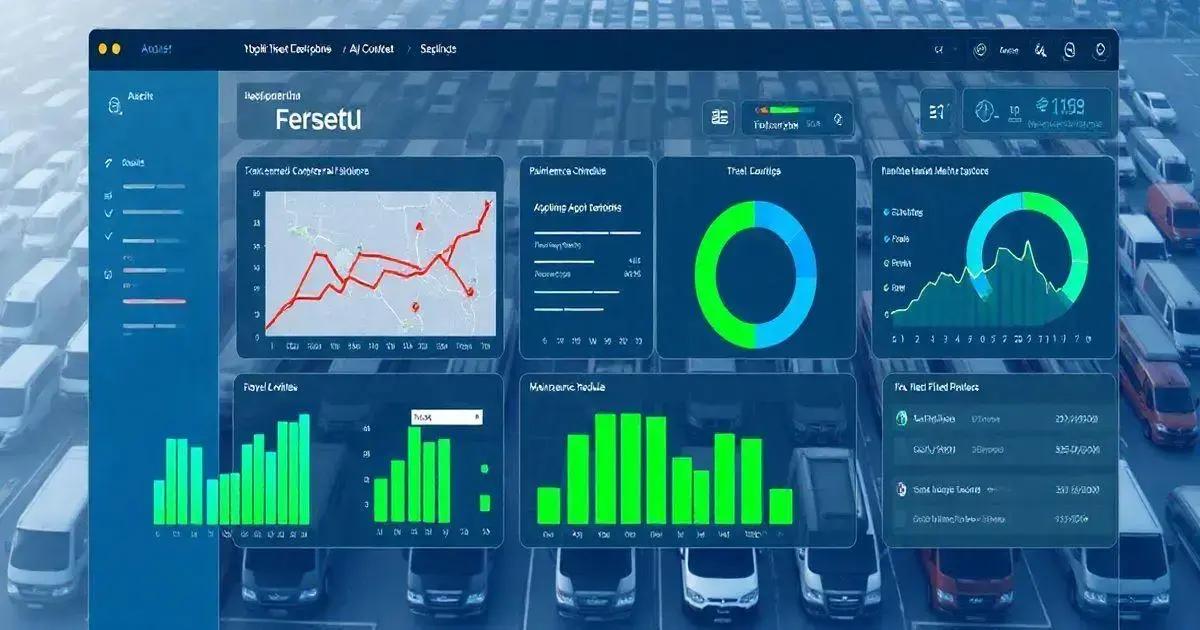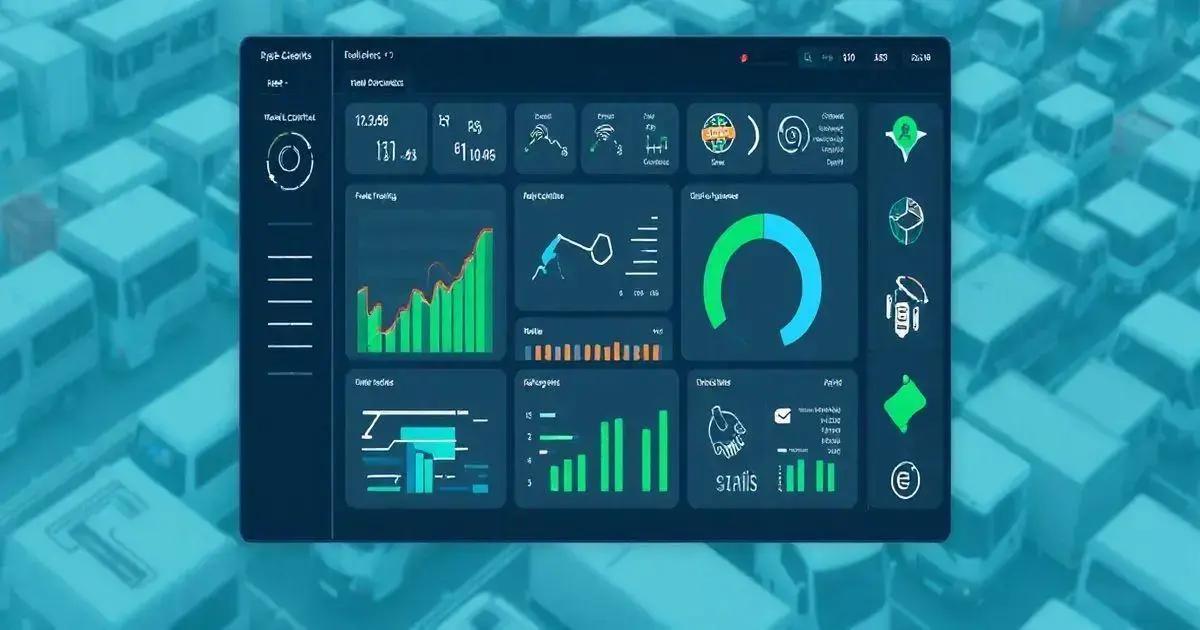10 Features of the Fleet Control Worksheet 7.0 You Need Leave a comment
The Fleet Control Worksheet 7.0 is an advanced fleet management tool that enhances operational efficiency through features like an intuitive dashboard for vital metrics, a travel and cargo control system for tracking trips and loads, and tire and maintenance management for vehicle longevity. It also includes a document management system for secure storage and easy access to essential paperwork, ensuring compliance and organization, making it an essential resource for fleet managers to reduce costs and maintain their fleets effectively in a competitive logistics environment.
The Fleet Control Worksheet 7.0 is designed to help businesses manage their fleet efficiently. With features like an initial dashboard, travel control, and maintenance tracking, this tool simplifies fleet management.
Introduction to Fleet Control
Managing a fleet of vehicles can be a daunting task, especially when you consider the various elements involved—maintenance, fuel consumption, travel logistics, and personnel management. The Fleet Control Worksheet 7.0 is an innovative tool that aims to simplify these processes and enhance productivity.
With this worksheet, users can take control of their fleet operations through comprehensive data management. It provides a user-friendly interface that allows for easy input and tracking of essential metrics, ensuring that all information is accessible at a glance.
Whether you’re a small business with a handful of vehicles or a large corporation managing a substantial fleet, the Fleet Control Worksheet 7.0 is adaptable to fit your needs. This tool not only helps in tracking costs but also aids in strategic planning and decision-making, streamlining operations to ultimately save time and resources.
In the sections to follow, we will dive deeper into the key features of this worksheet that make it a must-have for efficient fleet management.

Key Features of Fleet Control Worksheet 7.0
The Fleet Control Worksheet 7.0 comes packed with a variety of features tailored to enhance fleet management. Here are some of its key functionalities:
Initial Dashboard: The dashboard provides a quick overview of key performance indicators, such as kilometer usage, fuel consumption, and maintenance costs, enabling managers to make informed decisions at a glance.
Travel and Cargo Control: This feature allows users to track cargo loads and vehicle utilization, ensuring that every trip is logged and accounted for, helping to optimize routes and reduce empty miles.
Tire Control Management: Users can manage tire maintenance schedules and monitor tire conditions, which helps in preventing unexpected failures and prolonging tire life.
Preventive and Corrective Maintenance Tracking: Keep a detailed record of all maintenance activities—both scheduled and unscheduled—allowing for proactive management of vehicle health and compliance with regulations.
Cost Analysis: The worksheet enables users to analyze and compare costs related to fuel, maintenance, and operations, providing insights that can lead to cost-saving measures.
Document Management: Efficiently manage and store important documents related to drivers and vehicles, such as licenses, insurance, and maintenance records, all in one place.
User-Friendly Interface: The worksheet is designed with ease of use in mind, allowing users to enter data quickly and access information without hassle.
Customizable Features: Tailor the worksheet to suit your business needs with customizable fields and templates, ensuring that it aligns perfectly with your operational requirements.
Comprehensive Reporting: Generate detailed reports on fleet performance, maintenance history, and cost analysis to gain deeper insights and enhance accountability.
Compatibility: The worksheet is compatible with various versions of Excel and works seamlessly on different Windows operating systems, making it accessible for most users.
These features combine to create a powerful tool that not only helps in managing fleets but also improves operational efficiency and decision-making processes.
Initial Dashboard Overview
The Initial Dashboard of the Fleet Control Worksheet 7.0 serves as the command center for fleet managers, providing a comprehensive overview of vital metrics and performance indicators. Its intuitive design allows for quick access to essential information, making fleet management more streamlined and efficient.
Upon opening the worksheet, users are greeted with a visually appealing dashboard that highlights critical data points, including:
- Kilometers Driven: This metric displays the total kilometers driven by each vehicle, helping managers understand vehicle usage and identify any discrepancies that may indicate inefficiencies.
- Fuel Consumption: Track fuel usage in real-time, allowing users to analyze fuel efficiency and identify any potential issues related to fuel management. This feature can help in budgeting and forecasting fuel expenses.
- Maintenance Costs: The dashboard tracks and displays costs associated with preventive and corrective maintenance, enabling users to keep an eye on spending and plan for future maintenance needs.
- Average Maintenance Time: Monitor the average time taken for maintenance tasks, providing insights into operational efficiency and helping to maximize vehicle uptime.
- Vehicles in Transit: The dashboard shows a real-time count of vehicles currently on the road, giving managers a clear view of fleet activity at any given moment.
- Tire and Fuel Management: Visual indicators highlight the status of tire maintenance schedules and fuel levels, ensuring that users are aware of when to perform necessary checks or replacements.
This robust dashboard not only provides a snapshot of fleet performance but also allows for easy identification of areas needing attention. It’s designed to empower users to make data-driven decisions that enhance operational efficiency and lower costs.
Overall, the Initial Dashboard of the Fleet Control Worksheet 7.0 is an invaluable asset for any fleet manager, offering actionable insights that can lead to improved management and performance of fleet operations.

Travel and Cargo Control
The Travel and Cargo Control feature in the Fleet Control Worksheet 7.0 is essential for optimizing logistics and ensuring efficient management of both vehicles and cargo. This section of the worksheet allows fleet managers to meticulously track all aspects of travel and cargo operations.
Here’s a closer look at what this feature offers:
- Trip Tracking: Record each trip’s details, including the starting and ending locations, the distance traveled, and the trip duration. This provides a clear log of all movements and helps in analyzing routing efficiency.
- Load Management: Monitor cargo loads for each vehicle, which helps ensure that vehicles are utilized to their maximum capacity, reducing unnecessary trips and associated costs.
- Linking Cargo to Trips: Each cargo item can be linked directly to its respective trip, making it easy to manage and track what is being transported. This aids in accountability and transparency in cargo handling.
- Expense Tracking: Log all expenses related to each trip, including fuel costs, tolls, and any other incidental expenses. This data is crucial for budgeting and financial analysis.
- Real-Time Updates: Fleet managers can input updates on cargo status throughout the trip, allowing for enhanced tracking and communication. This is particularly useful in case of delays or changes in delivery schedules.
- Performance Metrics: Evaluate performance by analyzing key metrics such as delivery times, cargo weight against fuel consumption, and overall trip efficiency. This helps in identifying areas for improvement and optimizing future operations.
Incorporating these elements into the travel and cargo management process not only increases operational efficiency but also helps in minimizing costs and improving customer satisfaction. With the Fleet Control Worksheet 7.0, fleet managers can ensure that every journey is tracked, every cargo is accounted for, and operations run smoothly.
Tire and Maintenance Management
The Tire and Maintenance Management feature in the Fleet Control Worksheet 7.0 is designed to enhance the longevity and performance of fleet vehicles through proactive tracking and management of tire conditions and maintenance schedules.
Here’s how this feature contributes to efficient fleet management:
- Tire Inventory Tracking: Maintain a comprehensive record of all tires in your fleet, including details such as brand, type, size, and current condition. This ensures that managers have a clear overview of tire assets and can plan for replacements when necessary.
- Maintenance Scheduling: Set up preventive maintenance schedules based on mileage or time intervals. This helps in ensuring that vehicles receive timely service, reducing the likelihood of breakdowns and extending their operational lifespan.
- Tire Change Alerts: The worksheet includes features that alert managers when tires need to be rotated or replaced based on predetermined thresholds, ensuring optimal performance and safety.
- Cost Tracking: Log all expenses related to tire maintenance, including purchases, rotations, repairs, and replacements. This financial tracking allows for better budget management and analysis of overall tire-related costs.
- Condition Monitoring: Keep an eye on tire pressure, tread depth, and overall tire health. This monitoring can help identify issues early, allowing for corrective actions before they lead to more significant problems.
- Reporting Tools: Generate reports on tire performance, including metrics related to wear patterns and maintenance costs. These insights can aid in making data-driven decisions regarding tire purchases and maintenance strategies.
By effectively managing tires and maintenance schedules, fleet managers can significantly reduce costs, improve vehicle reliability, and enhance safety for drivers and cargo alike. The Tire and Maintenance Management feature in the Fleet Control Worksheet 7.0 is an essential tool for maintaining an efficient and safe fleet.

Document Management Systems
The Document Management Systems feature in the Fleet Control Worksheet 7.0 plays a crucial role in organizing and safeguarding all essential documents related to fleet operations. Effective document management ensures that vital information is readily accessible, improving overall efficiency and compliance.
Here’s how this feature enhances fleet management:
- Centralized Document Storage: Store all critical documents in a centralized digital location. This includes driver licenses, vehicle registrations, insurance certificates, maintenance records, and any other pertinent paperwork, making it easy to access whenever needed.
- Document Tracking: Keep track of all documents’ statuses, including expiration dates and renewal requirements. This prevents lapses in compliance and ensures that all documents are up-to-date, reducing the risk of fines or legal issues.
- Easy Retrieval: With a structured categorization system, users can quickly find and retrieve documents without wasting time searching through physical files or disorganized digital folders.
- Security and Backup: Ensure that sensitive information is protected through secure storage solutions. Regular backups of documents provide peace of mind, knowing that important files are safe from loss due to unforeseen events.
- Sharing and Collaboration: Facilitate collaboration among team members by allowing secure sharing of documents. This feature is especially useful for training material, policy documents, and operational guidelines that need to be accessible to multiple users.
- Audit Trails: Maintain a record of document modifications and access logs, providing a comprehensive audit trail for compliance purposes. This is important for regulatory inspections and internal reviews, enhancing accountability within fleet operations.
Overall, the Document Management Systems feature in the Fleet Control Worksheet 7.0 streamlines the management of essential documents, making fleet operations smoother and more efficient. By ensuring that all documentation is organized, secure, and easily accessible, fleet managers can focus more on optimizing their operations rather than being bogged down by paperwork.
Conclusion
The Fleet Control Worksheet 7.0 is an indispensable tool for businesses looking to optimize their fleet management processes.
With features such as an intuitive dashboard, travel and cargo control, tire and maintenance management, and robust document management systems, it empowers fleet managers to make data-driven decisions and improve operational efficiency.
By utilizing this worksheet, businesses not only enhance accountability and transparency but also reduce costs associated with fleet operations.
Ultimately, the Fleet Control Worksheet 7.0 helps organizations maintain a competitive edge in the logistics and transportation sectors, ensuring that their fleets are operating at peak performance.
Investing in effective fleet management solutions, like the Fleet Control Worksheet 7.0, is vital for long-term success in today’s fast-paced business environment.
FAQ – Frequently Asked Questions about Fleet Control Worksheet 7.0
What is the Fleet Control Worksheet 7.0?
The Fleet Control Worksheet 7.0 is a comprehensive tool designed to help businesses manage their fleet operations efficiently, providing features for tracking travel, cargo, maintenance, and documentation.
How does the dashboard work?
The dashboard provides an overview of key metrics like kilometers driven, fuel consumption, and maintenance costs, allowing fleet managers to make informed decisions at a glance.
Can I customize the worksheet to my needs?
Yes, the Fleet Control Worksheet 7.0 is customizable, allowing users to adjust fields and templates to fit their specific operational requirements.
Is it compatible with all versions of Excel?
The worksheet is compatible with various versions of Excel, including 2007, 2010, 2013, and 2016, ensuring accessibility for most users.
How does the tire and maintenance management feature work?
This feature tracks tire conditions, schedules maintenance, and logs costs associated with tire management, helping to prolong vehicle life and enhance safety.
What kind of documents can I manage with this worksheet?
You can manage various documents, including driver licenses, vehicle registrations, insurance certificates, and maintenance records, all in a centralized digital location.

